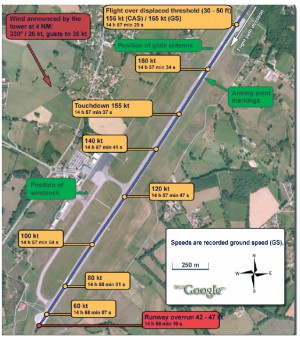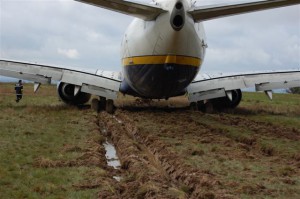Ryanair has had several accidents over the years, which I think makes our Chief Executives claim of an “unblemished 29-year safety record” a bit misleading. All airlines have incidents and most major airlines have also had one or several accidents. What is interesting from a safety point of view is what leads up to them.
As an example, lets discuss the Ryanair accident in Limoges, France. A storm with strong winds and heavy rain was closing in on Limoges airport as the Ryanair flight started the approach. The First Officer, who was undergoing initial line train ing, was flying the aircraft. During the approach the pilots were informed, but did not comprehend, that the wind had increased and changed direction, giving a tailwind well above the 10 knot limit. Just before landing the First Officer became unable to maintain the required flight path, and the Captain took control of the aircraft. The landing was made far into the runway. Because of a lot of water on the runway, braking efforts were not effective. The aircraft crossed the runway end at a speed of about 45 knots and continued into the grass. More details available on www.skybrary.aero
ing, was flying the aircraft. During the approach the pilots were informed, but did not comprehend, that the wind had increased and changed direction, giving a tailwind well above the 10 knot limit. Just before landing the First Officer became unable to maintain the required flight path, and the Captain took control of the aircraft. The landing was made far into the runway. Because of a lot of water on the runway, braking efforts were not effective. The aircraft crossed the runway end at a speed of about 45 knots and continued into the grass. More details available on www.skybrary.aero
Why did this accident happen? The obvious answer is the crew should have abandoned the landing when the tailwind was reported to be stronger then the limit. Pilot error – case closed. Or maybe not? Fact is, the tailwind decreased again to only 8 knots before landing, effectively within the limit. So, what caused the accident then?
- The Captain had just been appointed as a Training Captain, allegedly close to the minimum flight time experience required. The attrition rate in Ryanair is high and it is not uncommon for the company to apply some pressure to pilots to take the next step in their carriers, sometimes even before they themselves are ready for it.
- The total experience of the crew was low. Could this have contributed to them continuing the approach in the face of deteriorating weather conditions and their failure to comprehend wind information?
- During the landing roll the captain handled the thrust reverse, that help to stop the aircraft, in a way which made the reversers unavailable for a long period of time. Could this be due to lack of experience or lack of training in landing in these conditions?
- There was more water standing on the runway then reported by the tower controller. Limoges is a small airport with little traffic, which may make it difficult to provide frequently updated measurements on the runway state.
- The landing was made with Flap 30 and not Flap 40, which would have given a shorter landing distance. The Ryanair Operations Manual states that landings shall normally be made with Flap 30 since this is more fuel efficient. Ryanair is crazy about saving fuel, and you don’t want to get a letter for being in the bottom of the fuel league. Was this at the back of the Captains mind?
The crew did the best they could in a situation which was clearly difficult. The question is: What is Ryanair doing to prevent this from happening again? What is Ryanair doing to attract and keep experienced Captains? What is done to remove pressure on pilots to progress in their carriers too quickly and to save as much fuel as possible?
The answer, I am afraid, is: nothing.
